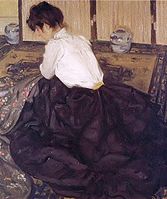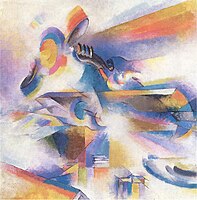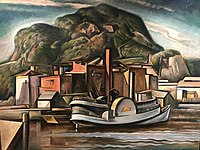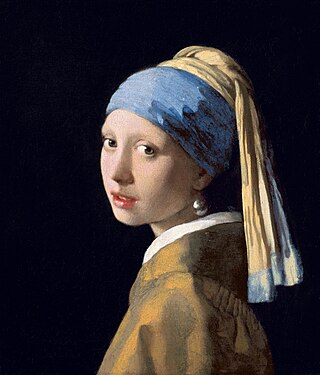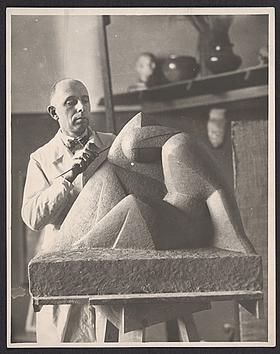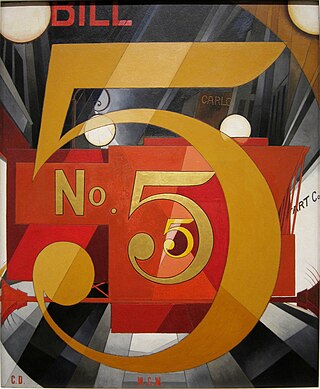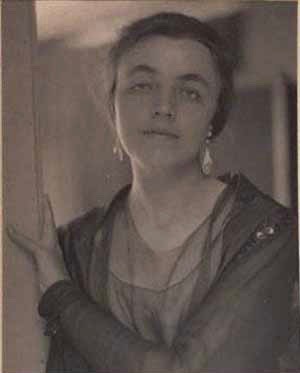Visual arts
American modernist painting
- Alfred Henry Maurer, An Arrangement, 1901
- Morgan Russell, Cosmic Synchromy (1913–14), Synchromism. Oil on canvas, 41.28 cm × 33.34 cm., Munson-Williams-Proctor Arts Institute.
- Oscar Bluemner, Form and Light, Motif in West New Jersey (1914)
- Andrew Dasburg, Improvisation, c. 1915–1916
- Stanton Macdonald-Wright 1920, Airplane Synchromy in Yellow-Orange, Synchromism
- Charles Demuth, Spring, 1921
- Stuart Davis, Lucky Strike, 1921
- Charles Demuth, Figure 5 in Gold, 1928
- Charles Rosen, Sidewheel in the Rondout, 1920's (Precisionism)
There is no single date for the beginning of the modern era in America, as dozens of painters were active at the beginning of the 20th century. It was the time when the first cubist landscapes (Precisionism), still-life and portraits appeared; bright colors entered the palettes of painters, and the first non-objective paintings were displayed in the galleries.
The modernist movement during the formative years was also becoming popular in New York City by 1913 at the popular Manhattan studio gallery of Wilhelmina Weber Furlong (1878–1962) and through the work of the Whitney Studio Club in 1918. [3] [4] According to Davidson, the beginning of American modernist painting can be dated to the 1910s. The early part of the period lasted 25 years and ended around 1935, when modern art was referred to as, what Greenberg called the avant-garde.
The 1913 Armory Show in New York City displayed the contemporary work of European artists, as well as Americans. The Impressionist, Fauvist and Cubist paintings startled many American viewers who were accustomed to more conventional art. However, inspired by what they saw, many American artists were influenced by the radical and new ideas.
The early 20th century was marked by the exploration of different techniques and ways of artistic expressiveness. Many American artists like Wilhelmina Weber, Man Ray, Patrick Henry Bruce, Gerald Murphy and others went to Europe, notably Paris, to make art. The formation of various artistic assemblies led to the multiplicity of meaning in the visual arts. The Ashcan School gathered around realism (Robert Henri or George Luks); the Stieglitz circle glorified abstract visions of New York City (Max Weber, Abraham Walkowitz); color painters evolved in direction of the colorful, abstract "synchromies" (Stanton Macdonald-Wright and Morgan Russell), whereas precisionism visualized the industrialized landscape of America in the form of sharp and dynamic geometrization (Joseph Stella, Charles Sheeler, Morton Livingston Schamberg, Charles Rosen, and Charles Demuth). Eventually artists like Charles Burchfield, Marsden Hartley, Stuart Davis, Arthur Dove, Georgia O'Keeffe who was thought of as the mother of American Modernism, John Marin, Arthur Beecher Carles, Alfred Henry Maurer, Andrew Dasburg, James Daugherty, John Covert, Henrietta Shore, William Zorach, Marguerite Thompson (Zorach), Manierre Dawson, Arnold Friedman and Oscar Bluemner ushered in the era of Modernism to the New York School.
The shift of focus and multiplicity of subjects in the visual arts is also a hallmark of American modernist art. Thus, for example, the group The Eight brought the focus on the modern city, and placed emphasis on the diversity of different classes of citizens. Two of the most significant representatives of The Eight, Robert Henri and John Sloan made paintings about social diversity, often taking as a main subject the slum dwellers of industrialized cities. The late 1920s and the 1930s belonged (among many others) to two movements in American painting, Regionalism and Social Realism. The regionalists focused on the colorfulness of the American landscape and the complexities of country life, whereas the social realists went into the subjects of the Great Depression, poverty, and social injustice. The social realists protested against the government and the establishment that appeared hypocritical, biased, and indifferent to the matters of human inequalities. Abstraction, landscape and music were popular modernist themes during the first half of the 20th century. Artists like Charles Demuth who created his masterpiece I Saw The Figure Five in Gold in 1928, Morton Schamberg (1881–1918) and Charles Sheeler were closely related to the Precisionist movement as well. Sheeler typically painted cityscapes and industrial architecture as exemplified by his painting Amoskeag Canal 1948. Jazz and music were improvisationally represented by Stuart Davis, as exemplified by Hot Still-Scape for Six Colors – 7th Avenue Style, from 1940.
Modernism bridged the gap between the art and a socially diverse audience in the United States. A growing number of museums and galleries aimed at bringing modernity to the general public. Despite initial resistance to the celebration of progress, technology, and urban life, the visual arts contributed enormously to the self-consciousness and awareness of the American people. New modernist painting shined a light on the emotional and psychic states of the audience, which was fundamental to the formation of an American identity.
Numerous directions of American "modernism" did not result in one coherent style.
Main schools and movements of American modernism
- the Stieglitz group
- the Arensberg circle
- color painters
- Precisionism
- the Independents
- the Philadelphia school
- New York independents
- Chicago and westward
Modernist painting
Georgia O'Keeffe, known as the "Mother of American modernism", [5] has been a major figure in American Modernism since the 1920s. She has received widespread recognition, for challenging the boundaries of modern American artistic style. She is chiefly known for paintings of flowers, rocks, shells, animal bones and landscapes in which she synthesized abstraction and representation. [6] Ram's Head White Hollyhock and Little Hills, from 1935 is a well known painting by O'Keeffe.


Arthur Dove used a wide range of media, sometimes in unconventional combinations to produce his abstractions and his abstract landscapes. Me and the Moon from 1937 is a good example of an Arthur Dove abstract landscape and has been referred to as one of the culminating works of his career. [7] Dove did a series of experimental collage works in the 1920s. He also experimented with techniques, combining paints like hand mixed oil or tempera over a wax emulsion.
African-American painter Aaron Douglas (1899–1979) is one of the best-known and most influential African-American modernist painters. His works contributed strongly to the development of an aesthetic movement that is closely related to distinct features of African-American heritage and culture. Douglas influenced African-American visual arts especially during the Harlem Renaissance.
One of Douglas' most popular paintings is The Crucifixion. It was published in James Weldon Johnson's God's Trombones in 1927. The crucifixion scene that is depicted in the painting shows several elements that constitute Douglas' art: clear-cut delineation, change of shadows and light, stylized human bodies and geometric figures as concentric circles in contrast to linear forms. The painting's theme resembles not only the biblical scene but can also be seen as an allusion to African-American religious tradition: the oversized, dark Jesus is bearing his cross, his eyes directed to heaven from which light is cast down onto his followers. Stylized Roman soldiers are flanking the scene with their pointed spears. As a result, the observer is reminded for instance of the African-American gospel tradition but also of a history of suppression. Beauford Delaney, Charles Alston, Jacob Lawrence and Romare Bearden were also important African-American Modernist painters that inspired generations of artists that followed them.
Modernist photography
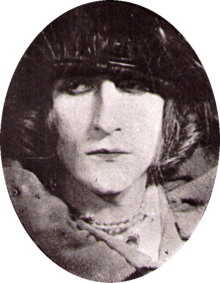
At the beginning of American modernism, photography still struggled to be recognized as a form of art. The photographer Alfred Stieglitz described it as: "Artists who saw my earlier photographs began to tell me that they envied me; that they felt my photographs were superior to their paintings, but that, unfortunately, photography was not an art. I could not understand why the artists should envy me for my work, yet, in the same breath, decry it because it was machine-made." (Stieglitz:8). In 1902, Stieglitz founded the Photo-Secession group with members such as Edward Steichen, Gertrude Käsebier and Clarence Hudson White, which had the objective of raising the standard and increasing the awareness of art photography. At that point, their main style was pictorialist , which was known for modifying photos through soft focus, special filters or exotic printing processes, to imitate the style of paintings and etchings of that time. For means of publication, Stieglitz, as the driving force of the movement, started the magazine Camera Work , in which he published artists he felt represented the movement. He also ran three galleries one after another, namely "291" (1905–1917), "The Intimate Gallery" (1925–1929) and "An American Place" (1929–1947). Especially 291 served as a meeting point for artists and writers and was the first to exhibit the early modernist art works of European artists, such as Henri Matisse, Auguste Rodin, Henri Rousseau, Paul Cézanne, and Pablo Picasso, in the United States. A further link to the European avant-garde was established by Man Ray. Born in America and inspired by the work he saw in Stieglitz' galleries, Ray emigrated to Paris in 1921 and together with artists of the European Dada and Surrealist movements created new photographic techniques such as rayographs (placing objects directly on photosensitive paper).
In the early 1920s, photographers moved towards what they called straight photography . In contrast to the pictorialist style, they now rejected any kind of manipulation in the photographic process (e.g., soft lens, special developing or printing methods) and tried to use the advantages of the camera as a unique medium for capturing reality. Their motifs were supposed to look as objective as possible. Turning the focus away from classic portraiture and the pictorialist style, the photographers started using their pictures as means for representing the harsh realities of everyday life, but at the same time tried to search for the beauty in the detail or the overall aesthetical structure. Machines and factory work, sky scrapers and technical innovations became prominent motifs. In 1932 some younger photographers (e.g. Ansel Adams, Imogen Cunningham, Willard Van Dyke, Edward Weston) started Group f/64 based on the ideals of straight photography, which became the most progressive association of its time.
